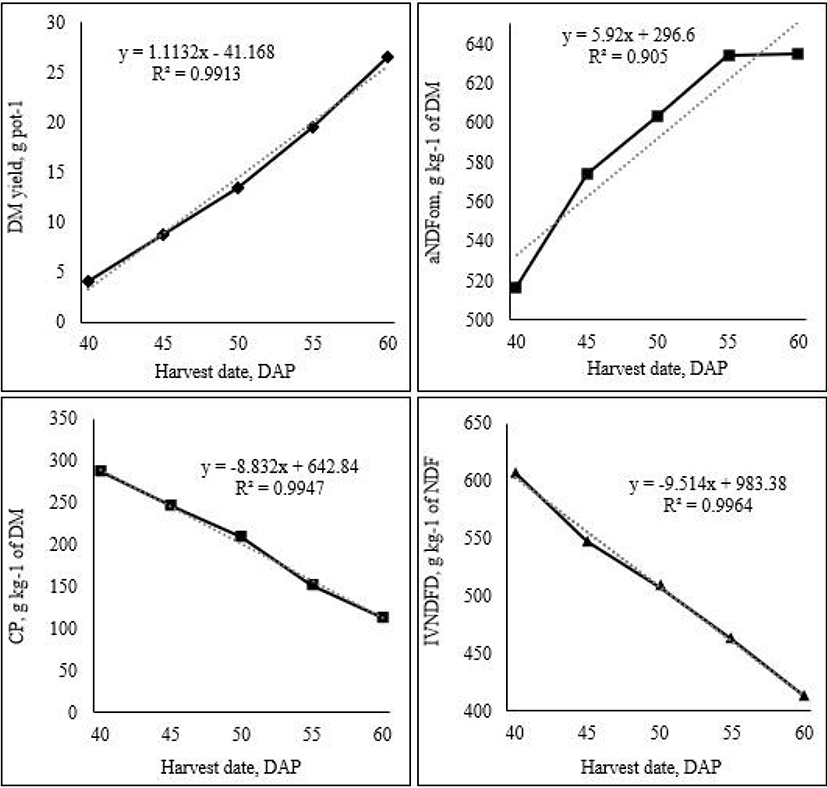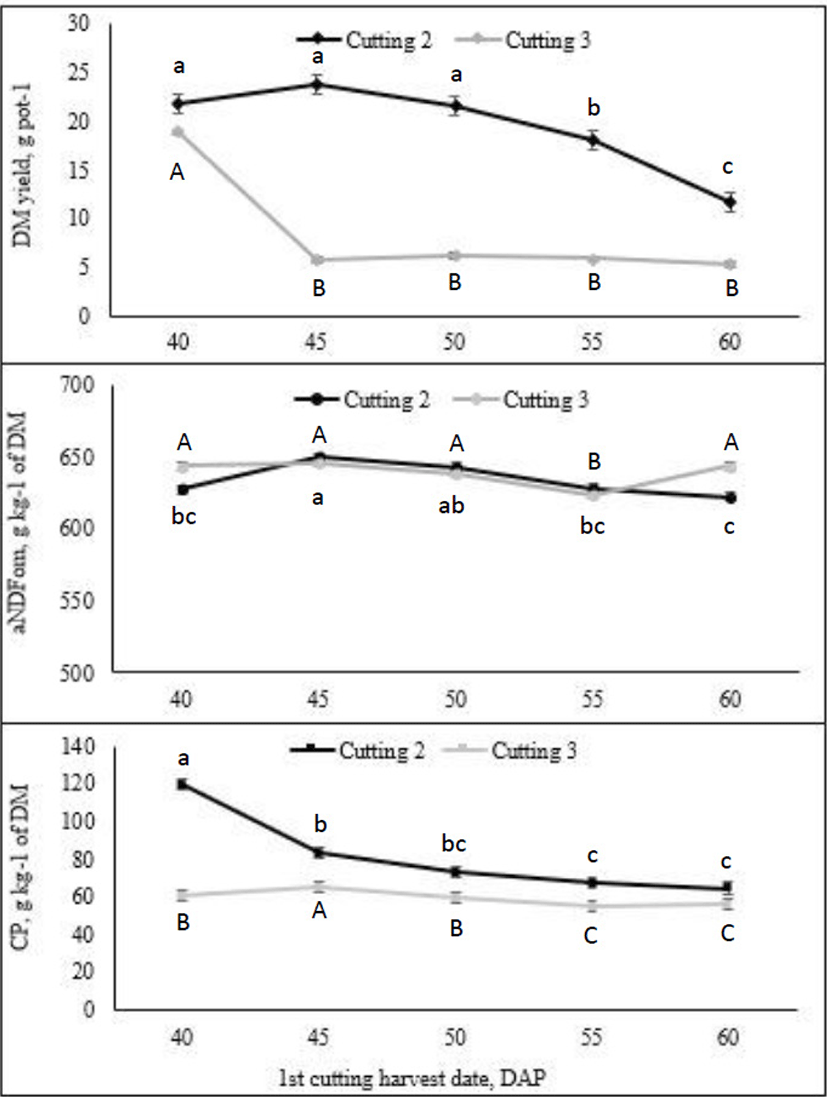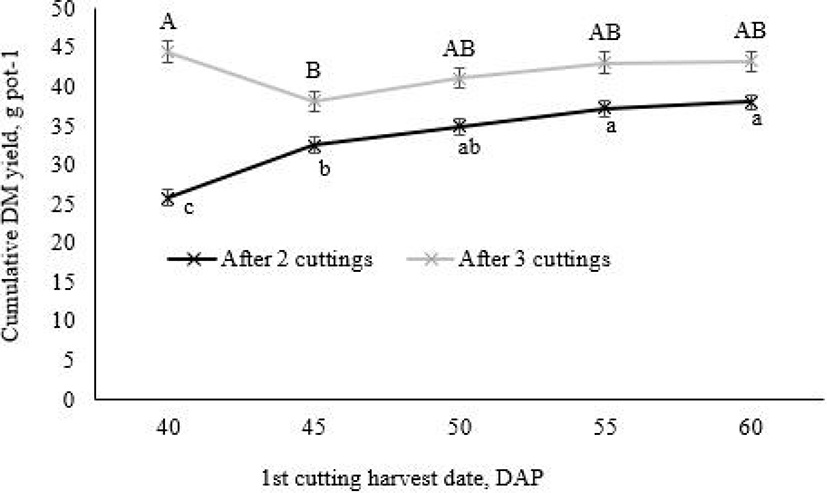INTRODUCTION
One of the most pressing issues facing the dairy industry is drought. In the Southwestern and High Plains regions of the United States, where annual precipitation is low, irrigation for growing feed presents the greatest water-utilization challenge for dairy producers. More than 90% of the water used to support a dairy farm is devoted to producing crops that feed the cattle [1]. While the dairy industry has seen impressive growth in states like Kansas, New Mexico, and Texas, ground water levels in these areas have been decreasing at an alarming rate [2]. As ground water levels drop, some wells are no longer able to provide fields with the intended volume of water. Given the high water demands of crops like alfalfa and corn, and that alfalfa hay and corn silage are the most commonly fed forages in the dairy industry, the sustainability of the dairy industry in the Southwest and High Plains is questionable without an intentional shift toward more water-efficient forage crops.
Water-efficient warm-season forage crops with nutritional profiles aligned to the requirements of livestock could prove an attractive alternative to traditional forages like alfalfa and corn silage. Teff (Eragrostis tef) is a warm-season annual grass (C4 physiology) native to Ethiopia that is well-adapted to arid conditions. For thousands of years, teff has been used as a grain crop for human consumption [3]. Once introduced to the United States, however, researchers began evaluating teff as a forage crop [4]. In 2018, corn silage and alfalfa yield in Kansas, New Mexico, and Texas averaged 14.8 and 11.4 t of dry matter (DM) per ha, respectively [5]. In comparison, teff has potential to yield 12.4 t of DM per ha with adequate irrigation and fertilization [4,6,7]. Yield data for teff is scarce, however, and may be biased by limitations in our knowledge of teff management, including management of harvest maturity and how this impacts annual yield.
While teff has potential to fit the needs for forage production in water-stressed regions, very little is currently known about its nutritional characteristics and whether it can support high levels of milk production by dairy cattle. In Ethiopia, because teff is primarily grown as a grain crop, most feeding trials have aimed at improving the nutritive value of low-quality teff straw [8–10]. Additionally, studies that have investigated the quality of teff before it reaches full maturity have reported nutritive values that are highly variable. The crude protein (CP) concentration of teff has been reported to range anywhere from 85 to 215 g/kg of DM [4,6,7,11]. The neutral detergent fiber (NDF) concentration, a predictor of intake in ruminants, has been reported to range from 525 to 725 g/kg of DM [4,6,11]. Due to the extreme variation in reported nutritive values for teff, it is difficult to know at this point if teff is a suitable forage source for high-producing dairy cows. Given that the productivity of a dairy cow is highly dependent on forage nutritive value and digestibility [12], standardized nutrient and digestibility values for teff should be established before the productivity of cows fed teff can be investigated. Because both cultivar and time of harvest play a crucial role in dictating the nutritive value of a given forage, the objective of this study was to investigate the effect of cultivar and harvest days after planting (DAP) on DM yield and nutritive value of teff. We hypothesized that relatively early first harvest would result in ideal nutritive value of the forage while maximizing yield across cuttings.
MATERIALS AND METHODS
This experiment was conducted in a climate-controlled greenhouse space at Kansas State University (Manhattan, KS, USA). Temperature in the designated space ranged from 20°C to 31°C, with an average temperature of 25°C. Fourteen h of light d−1 were provided as a combination of both natural and artificial light. Eighty plastic pots (3.78 L) were blocked by location and randomly assigned to four teff cultivars and five harvest times. The 20 treatment combinations were assigned in replicates of four. The four cultivars used in this study were Corvallis, Dessie, Moxie, and Tiffany, representing the varieties that have been most widely evaluated in North America [13–16]. All four cultivars were commercially available at the start of the study and coated. Although the exact coating used on the seeds is proprietary, most seed coatings consist of a combination of lime to regulate soil pH, fertilizer to direct specific nutrients to the site of seed-soil contact, as well as insecticides and fungicides, held together by a binding agent. Coating grass seeds can both enhance germination and add weight to the seeds for easier and more uniform sowing [17].
Seeds were planted in Metro Mix 360 (Sungro Horticulture, Agawam, MA) at a rate of 30 seeds/pot (equivalent to 16.81 kg/ha) and to an average depth of 0.48 cm. At planting, 0.15 g of urea (equivalent to 56 kg N ha−1) was applied to each pot and the pots were lightly watered with a spray bottle. Pots were watered daily with a spray bottle until the seedlings were strong enough to withstand watering with a hose. Mature plants were watered two to three times per week to maintain “well-watered” conditions. An additional 0.15 g of urea (equivalent to 56 kg N ha−1) was applied to all pots at d 60 after planting. Pots were harvested at one of the following five times: 40, 45, 50, 55, and 60 DAP.
Each pot was harvested at the assigned time. Entire plants were cut with gardening clippers to a height of 10 cm and top biomass was collected and weighed. To assess the carryover effects of first-cutting harvest time on nutritive values, a second cutting was taken from each pot 30 d after the first cutting. A third cutting was taken 30 d after the second cutting. After the third cutting, regrowth was insufficient to justify a fourth cutting.
Harvested samples were placed in paper bags and dried at 55°C in a forced-air oven for 72 h. After 24 h of air equilibration, dried samples were weighed to determine DM yield. Samples were then ground through a 1-mm screen using a Cyclone Sample Mill (UDY, Fort Collins, CO, USA). Concentrations of amylase-treated, ash-free neutral detergent fiber (aNDFom) were determined in the presence of sodium sulfite [18] using an Ankom Fiber Analyzer (ANKOM Technology, Macedon, NY, USA). CP was determined by oxidation and detection of N2 (LECO Analyzer, LECO, St. Joseph, MI, USA), multiplied by 6.25. Concentrations of all nutrients except for DM were expressed as percentages of DM determined by drying at 105°C in a forced-air oven for more than 8 h. In vitro NDF digestibility (IVNDFD) was analyzed using a DAISY Incubator (ANKOM Technology). Ground grass samples were placed in filter bags with 25 µm porosity (ANKOM Technology) and incubated for 24 h in rumen fluid collected from a mature Holstein steer fed a 50:50 forage: concentrate diet. Once removed from incubation, samples were dried at 55°C and transferred to an Ankom apparatus to determine NDF concentration of the residue. Second- and third-cutting samples were analyzed by Dairy One Forage Testing Laboratory (Dairy One, Ithaca, NY, USA) using identical analytical techniques.
The data were analyzed using JMP (version 10.0, SAS Institute, Cary, NC, USA). An analysis of variance was conducted to analyze how the fixed effects of cultivar, harvest time, and their interaction influenced dependent variables. Independent variables were declared significant at p < 0.05 and means were separated by Tukey’s HSD (honestly significant difference) test.
RESULTS AND DISCUSSION
Plant maturity at harvest is one of the principal factors influencing forage nutritive value and digestibility [19]. With the development of higher-quality and more digestible cultivars, however, plant genetics are playing an increasingly crucial role in determining the overall nutritive value of a given forage. Researchers worldwide have investigated the effect of cultivar on the nutritive value and digestibility of a number of forage types including alfalfa (Medicago sativa) [20], corn silage (Zea mays) [21], sorghum (Sorghum bicolor) [22], tall fescue (Festuca arundinacea) [23], oats (Avena sativa), and vetch (Vicia spp.) [24] to name a few. There are multiple cultivars of teff on the market today; some are better for grain production, others for forage production. Grain types tend to mature earlier than forage types, resulting in lower DM yields and reduced nutritive value [4]. In this experiment, all four cultivars evaluated were bred for forage production. After the first cutting, cultivar had no effect (p > 0.30) on DM yield, aNDFom, CP, or IVNDFD (Table 1).
Harvest DAP, however, had significant impacts on first-cutting forage yield, nutritive value, and digestibility (Fig. 1). It has been recommended that teff be harvested between 45 and 50 DAP to ensure that plants have adequate reserves for regrowth [4]. In the current study, DM yield increased linearly (p < 0.001) from 4.1 to 26.4 ± 0.45 g/pot as time of harvest increased from 40 to 60 DAP. Additionally, aNDFom concentration increased (p < 0.001) from 517 to 635 ± 8.1 g/kg of DM with increasing DAP and CP decreased linearly (p < 0.001) from 287 to 112 ± 4.9 g/kg of DM. As forages mature, nutritive value decreases as photosynthetic products such as glucose are converted to fibrous, structural components [19]. Grasses like teff, as opposed to legumes, have higher structural components such as hemicellulose, cellulose, and lignin in both their leaves and stems. Therefore, the nutritive value of grasses tends to decline more rapidly than that of legumes [19]. In this study, the CP concentration of first-cutting teff decreased linearly at a rate of 8.8 g kg−1 d−1 (Fig. 2). Similar trends have been seen with bromegrass (Bromus inermis) [25] and sorghum-sudangrass (Sorghum bicolor drummondii) [26]. The average greenhouse temperature (25°C) could explain the higher-than-expected CP concentration of teff cut at 40 and 45 DAP. Lower temperatures slow the maturation process and the subsequent production of fibrous structural compounds thus improving CP concentration and overall forage nutritive value [19].


Harvest DAP also had a significant effect on the IVNDFD of first-cutting teff (Fig. 1). As time of harvest increased from 40 to 60 DAP, IVNDFD decreased linearly (p < 0.001) at a rate of 9.5 g kg−1 d−1 (608 to 412 ± 10 g/kg). The NDF component of teff, like all forages, is composed primarily of cellulose, hemicellulose, and lignin. Lignin represents the indigestible fraction of NDF [19]. As a plant matures, lignin concentration increases, ultimately decreasing the overall digestibility of the fiber [27]. Other studies have confirmed this trend [25,26]. In a meta-analysis conducted by Oba and Allen [28], it was observed that enhanced forage NDF digestibility increased intake and milk yield of dairy cows. In addition, Oba and Allen [28] found that IVNDFD, specifically, is an accurate predictor of productivity of cows fed a given forage. While the nutrient composition and digestibility of forages grown in a greenhouse are not always the same as those grown in the field, other studies have used nutritive value and digestibility measurements of greenhouse grown forages as initial estimates of what could be expected in a more practical cultivation scenario [20,29]. No interaction between cultivar and time of cutting was observed for DM yield, nutritive value, and IVNDFD of teff (p > 0.10).
After the second cutting, cultivar had no effect (p = 0.47) on DM yield, aNDFom concentration (p = 0.13), or CP concentration (p = 0.84, Table 1). Additionally, there was no effect (p = 0.30) of cultivar on the cumulative DM yielded from the two cuttings. First-cutting harvest time had a significant effect (p < 0.001) on second-cutting DM yield as well as second-cutting aNDFom and CP concentrations (Fig. 2). Dry matter yield after the second cutting decreased from 23.68 to 11.59 ± 0.91 g/pot when first-cutting harvest time increased from 40 to 60 DAP. We found that second-cutting aNDFom concentration was greatest (p < 0.001) in those samples that were first cut at 45 and 50 DAP. CP concentration of the second-cutting teff decreased dramatically, from 119.4 to 64.3 ± 3.2 g/kg of DM, when first-cutting harvest time was increased from 40 to 60 DAP. No interaction between cultivar and time of first cutting was observed for DM yield, nutritive value, and IVNDFD of second-cutting teff (p > 0.10).
After the third cutting, again, cultivar had no effect (p = 0.40) on DM yield, aNDFom concentration (p = 0.10), or CP concentration (p = 0.48, Table 1). Additionally, cultivar had no effect (p = 0.49) on the cumulative DM yielded from the three cuttings. Like what was seen after the second cutting, first-cutting harvest time had a significant effect (p < 0.001) on third-cutting DM yield, aNDFom concentration, and CP concentration (Fig. 2). DM yield decreased from 18.70 to 5.24 ± 0.30 g/pot when first-cutting harvest time increased from 40 to 60 DAP. Third-cutting aNDFom concentration was greatest in samples originally cut at 45 DAP and least in those cut at 55 DAP (p < 0.001). CP was greatest in samples originally cut at 45 DAP and least in those cut at 55 DAP. No interaction between cultivar and time of first cutting was observed for DM yield, nutritive value, and IVNDFD of third-cutting teff (p > 0.10).
Whereas cultivar had no effect on the agronomic characteristics of teff, first-cutting harvest time played a critical role in influencing yield and nutritive values after the second and third cutting. According to Van Soest [19], photosynthetic compounds (i.e., glucose) are either stored or converted to structural material in plants. In a young warm-season grass plant, most of these photosynthetic compounds are stored in the form of starch. Stored root carbohydrates are crucial for regrowth. When grasses are harvested during the late vegetative to early boot stage (40 to 45 DAP), these stored root carbohydrates assist in the regrowth process and improve overall nutritive values. Grasses harvested during the boot to early heading stage (55 to 60 DAP), however, have already converted a large portion of these photosynthetic compounds to structural compounds. These structural compounds are mostly unavailable to the plant and cannot be used as a source of nutrients [19]. Therefore, root carbohydrates are utilized for regrowth of immature teff, ultimately reducing subsequent yield and protein concentration while increasing the fiber concentration.
Delaying the first cutting from 40 to 60 DAP had a significant impact on the cumulative DM yielded over the course of the trial (Fig. 3). After two cuttings, delaying the first cutting from 40 to 60 DAP significantly increased (p < 0.001) total DM yield from 25.76 to 38.00 ± 1.11 g/pot. This was most likely due to the fact that the first-cutting yield from plants harvested at 40 and 45 DAP was so low that the cumulative yield for the early-cut plants was still less than that of the late-cut plants after two cuttings, despite having a relatively higher second-cutting yield. After three cuttings, however, a first-cutting harvest at 40 DAP yielded significantly more (p < 0.01) DM than a first-cutting harvest at 45 DAP (44.47 vs. 38.15 ± 1.29 g/pot, or roughly 26 vs. 22 t DM/ha) and numerically more DM than first-cutting harvests at 50, 55, and 60 DAP. After three cuttings, the advantage of harvesting a plant at an earlier maturity during the first cutting significantly outweighed the greater first-cutting yield of a more mature plant. It is important to note that, although yield data collected from the greenhouse is useful for detecting differences among cultivars and first-cutting harvest times, yields observed in field trials do not typically match those observed in a controlled greenhouse setting.

Finally, across all cultivars and harvest times, the second cutting yielded significantly more DM (p < 0.01) than the first and third cuttings, and the first cutting yielded significantly more DM (p < 0.001) than the third cutting (Table 2). Additionally, aNDFom concentration increased (p = 0.01) and CP decreased (p < 0.001) when cutting number increased from one to three. Van Soest [19] describes lignification as one of a plant’s protective mechanisms against predatory attack or, in this case, a harvest event. As cutting number increases, then it is expected that the concentration of the protective, fibrous component of teff would increase. This is supported by the fact that, as cutting number increased from one to three, forage DM concentration at harvest increased (p < 0.001) from 199.6 to 313.7 ± 9.2 g/kg (Table 2). Reid et al. [30] reported a similar trend with smooth bromegrass. As cutting number increased from one to four, yield and digestibility tended to decrease while lignin concentration increased. The decrease in the CP concentration as cutting number increased could be due to both the increase in the fiber portion of the plant as well as the overall depletion of N and other key nutrients from the soil over time. While additional N (0.15 g of urea) was applied at d 60, N was not applied between the second and third cutting.
CONCLUSION
Results from this study indicate that, under greenhouse conditions, the first cutting of teff should be harvested at 45 to 50 DAP to optimize forage yield, nutritive value, and digestibility in that cutting and in subsequent cuttings. Overall, the nutrient profile of teff is similar those of other commonly fed grass forages like smooth bromegrass and sorghum-sudangrass. To use teff in the diet of a high-producing dairy cow, maturity at first cutting and soil fertility must be well managed to ensure that the forage provided in the diet is of the highest nutritive value possible.
















